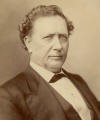Biographical Details
Date of Birth: January 19, 1820
Birth Location: New Albany, IN, USA
Major Study: Law
Graduation Year(s): 1845
Degree(s) Earned: Bachelor of Laws
Date of Death: April 3, 1879
Death Location: Indianapolis, IN, USA

Date of Birth: January 19, 1820
Birth Location: New Albany, IN, USA
Major Study: Law
Graduation Year(s): 1845
Degree(s) Earned: Bachelor of Laws
Date of Death: April 3, 1879
Death Location: Indianapolis, IN, USA
Samuel Hamilton Buskirk was born in Indiana in 1820, the fourth of six children, to George Abram Buskirk and Mary Boswell Buskirk. He had two older sisters and one elder brother. Shortly after his birth, his family moved to a farm in Bloomington. When he was nine, his brother, George [Jr.], was born, and when he was eleven, his brother, Edward, was born.
Samuel Hamilton Buskirk was one of three Buskirk brothers to receive law degrees from IU between 1845 and 1863. He received his early education at the common schools of Bloomington. After serving as Monroe County recorder from 1844 to 1845, he began practicing law in 1845. He was the Monroe County Prosecuting Attorney in 1851. In 1857, when the voters of Bloomington elected to dissolve the municipal government, he led the group to decide how to handle the town’s assets until a new government could take its place. He was appointed a director of the Indiana State Prison in 1859.
Buskirk served five terms in the Indiana House of Representatives (beginning in 1849) and was briefly Speaker of the House in 1863. In April 1865, he delivered the eulogy for President Abraham Lincoln at Bloomington’s massive public memorial service. His last year of serving in the state legislature was 1866.
Buskirk was elected to the Supreme Court of Indiana in 1870 for a term lasting from January 3, 1871 to January 1, 1877. During his time on the Supreme Court, he wrote Buskirk's Practice (1876), a manual of Supreme Court practice. About this time, Buskirk moved from Bloomington, where he had spent nearly all of his life, to Indianapolis, where he continued private practice and became president of the local bar association.
In 1845, Buskirk married Sarah Jewell Walter. They had six children.
In November 1874, Buskirk made his most famous court decision, Cory vs. Carter, in the Indiana Supreme Court, upholding the “separate but equal” racially segregated education.He reversed Indianapolis’ prior court decision that would have required an all-white school to admit black children.
In 1896, the U. S. Supreme Court referred to Buskirk’s 1874 court decision in Plessy vs. Ferguson, thereby upholding the constitutionality of racial segregation laws for “separate but equal” public facilities. The resultant quick proliferation of segregation proved a major setback to stop the civil rights integration that had briefly taken root after Abraham Lincoln’s presidency.